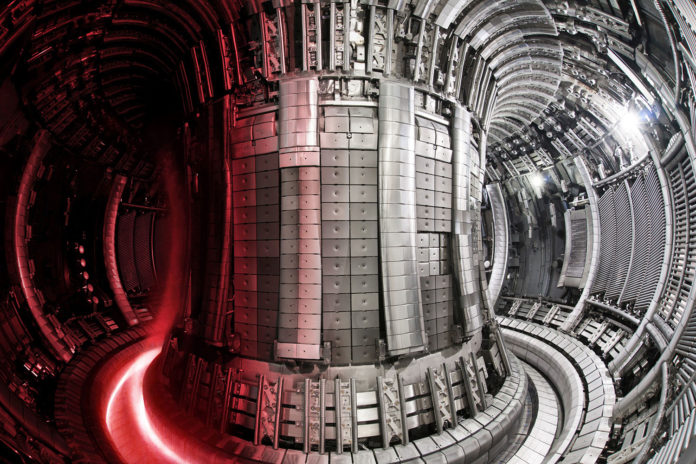EUROfusion scientists and engineers at the UK Atomic Energy Authority (UKAEA) announced the Joint European Torus (JET), the largest and most powerful operational nuclear fusion reactor called a tokamak, has produced the record-breaking 59 megajoules of sustained fusion energy in the form of neutrons during a five-second phase of a plasma discharge.
During this experiment, the JET achieved a power output of just over 11 megawatts, averaged over five seconds. The previous energy record, set in 1997, was just under 22 megajoules of total energy, and 4.4 megawatts of power averaged over five seconds. However, the peak power of 16 MW achieved briefly in 1997 has not been surpassed in recent experiments, as the focus has been on sustained fusion power.
The team used the same fuel mixture to be used in commercial fusion energy power plants. The larger French-based project and future power plants aim to fuse the hydrogen isotopes deuterium and tritium and release large amounts of energy in the process.
“We can explore the physics in fusion plasmas very well by working with hydrogen or deuterium, so this is the standard worldwide,” explains Dr. Athina Kappatou from the Max Planck Institute for Plasma Physics (IPP). “However, for the transition to the international, large-scale, fusion experiment ITER, it is important that we prepare for the conditions prevailing there.”
The International Thermonuclear Experimental Reactor (ITER) is currently under construction in Cadarache, in southern France, and is expected to be able to release ten times as much energy as is fed into the plasma in terms of heating energy, using deuterium-tritium fuel.
To achieve the new record, the European tokamak underwent a profound transformation. The previous carbon lining of the plasma vessel was replaced by a mixture of beryllium and tungsten, as is also planned for ITER, between 2009 and 2011. This modification enabled the researchers to produce stable plasma with the deuterium-tritium fuel that released 59 megajoules of energy.
The experimental facility is too small to produce net energy – that is, to release more energy than the heating systems provide. This will not be possible until the larger-scale ITER experiment in southern France comes online. “The latest experiments at JET are an important step toward ITER,” concludes Prof. Sibylle Günter, Scientific Director of the Max Planck Institute for Plasma Physics. “What we have learned in the past months will make it easier for us to plan experiments with fusion plasmas that generate much more energy than is needed to heat them.”
However, this success is a major step forward on fusion’s roadmap as a safe, efficient, low-carbon means of tackling the global energy crisis.
